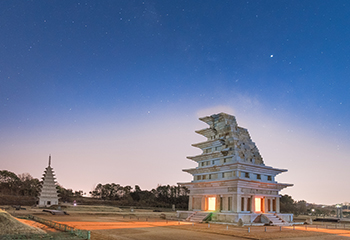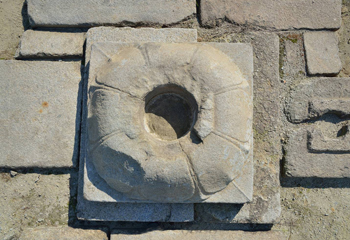Mireuksa Temple Site
The Mireuksa Temple Site, located in Mireuksan Mountain (430m above sea level), Geumma myeon, Iksan, has been the largest temple site discovered in East Asia.

The story of Mireuksa Temple was exceptionally written in the 13th-century Korean historical document Samgukyusa (“Memorabilia of the Three Kingdoms”) as one of Baekje’s temples. According to this ancient record, when King Mu and his wife were on their way to Sajasa Temple, the Maitreya triad appeared from the pond below Yonghwasan (now Mireuksan) Mountain. At the request of the queen, the pond was filled and the pagodas, prayer hall, and corridors were built on three different units.
Mireuksa Temple was a national monument that mobilized Baekje’s national power. Also, the layout of buildings in this temple were in accordance with the Buddhist sc
Most of these statements were approved by archeological investigations carried out for 23 years starting in 1974. The findings indicated that the temple was established in the early 7th century during the reign of King Mu and was demolished around the time of the Japanese invasion of Korea in 1592.
Mireuksa Temple displays a unique layout in which three units of the “one pagoda and one prayer hall” style structures stand in a row, and the central gate, pagoda, and prayer hall are arranged to a straight line in each unit. The size of the unit in the center is larger than that of the east and west units.
The east unit, the central unit, and the west unit were independent divided by long corridors. However, they all converged to one whole unit of a large lecture hall in the north. This means that the place to worship Buddha was segmented into three units, but that the single lecture hall eventually combined them into one. Corridors to the north, east, and west, converged at the lecture hall which were used as monks’ dormitories.
This temple is 134m in length from the lecture hall to the main gate, and 172m wide from outside the east unit to outside the west unit.
The waterway originating from Mireuksan Mountain was flown into artificial water paths on four sides of the temple. The remaining traces of a large pond were found at the south of the temple. On the north side of the lecture hall are two bridges over the artificial water route. Rear garden section was located behind the watercourse. Originally, a thoroughly designed drainage system was specifically applied to the construction of this temple where were wetland. The prayer hall of each unit had a special structure to ward off humidity. Foundation stones were laid on the floor of the prayer hall and 1m-thick cornerstones were laid out in a diamond shape above it. The remains of wooden supports on top of the cornerstones made an empty room at the floor of the prayer hall.
The Mireuksa Temple’s design was unprecedented layout ba

There were initially three pagodas at Mireuksa Temple – a wooden pagoda in the central unit and a stone pagoda in each of the east and west units. It is hard to know when the wooden pagoda vanished from the central unit. The stone pagoda in the eastern unit was completely collapsed when it was excavated in the 20th century, and the stone materials for the pagoda were left scattered nearby. The stone pagoda in the western unit preserved its general shape but in an unstable condition, and many parts were damaged. Only its northeastern side up to the sixth story remained in the 20th century.
A structural safety inspection performed in 1998 raised a concern over the stability of this western stone pagoda. The National Research Institute of Cultural Heritage has been staging a full investigation and has been conducting repair and maintenance on this pagoda since 2001. Academic research has been in full force since 2002.
The cavity in which the sarira was stored was found in 2009 in the middle of the top surface of the first-story stone of the western pagoda, discovered during a deconstructive investigation. Cross-shaped lines in ink and lime seals were also discovered around the cavity. Sarira reliquaries were kept inside this aperture and various offerings to Buddha, such as gold plates bearing insc
An examination of the gold plates bearing the records on the sarira enshrinement revealed that the stone pagoda in the west unit was built in 639. This constitutes a rare example of an artifact enough to prove historical recored that Mireuksa Temple was established during the reign of King Mu of the Baekje Kingdom.










